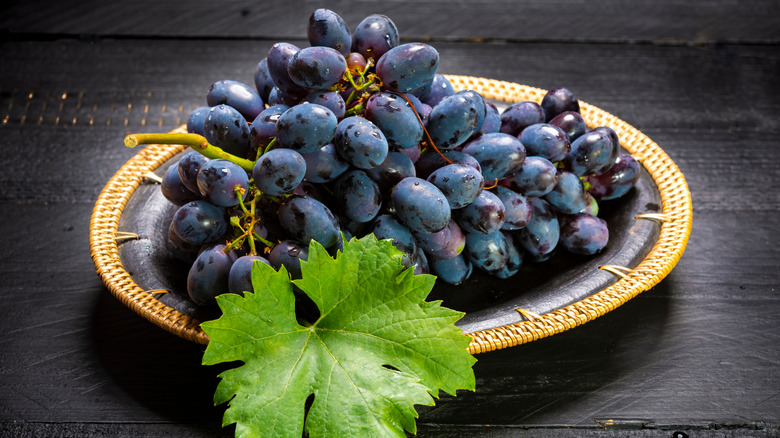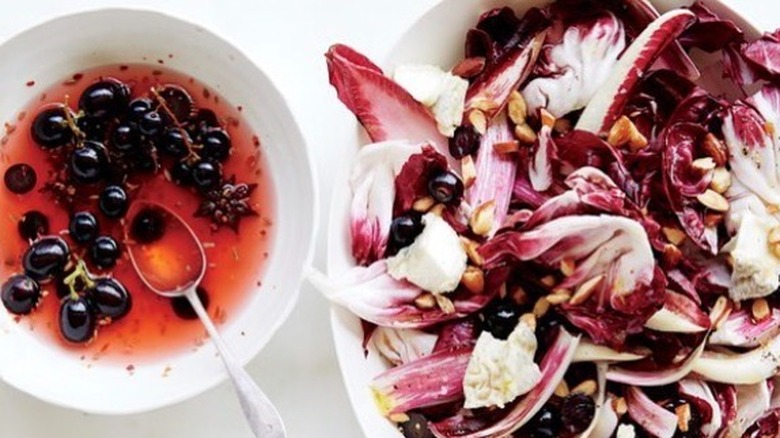Thomcord Grapes Are The Tasty Product Of A Farming Experiment
Who knew the United States Department of Agricultural (USDA) operates a grape-breeding program that turns 100 years old in 2023? The USDA's primary research agency, known as the Agricultural Research Service (ARS), has been conducting research and experiments on grapes since 1923, thanks to grape farmers in produce-heavy California. The state is by far the largest grape-growing region in America, doling out 5.76 million tons in 2021 alone, according to Statista.
That explains the proliferation of wineries in the state, as well as the number of consumers gobbling fresh grapes to the tune of 8.2 pounds per person, per year, on average, for every American. It makes sense then that the ARS spent 17 years developing a single new grape species. The juicy newcomer, compared to other varieties, answers to the name of Thomcord, which is more than suitable given its impressive lineage. Rather than growing wild as a product of nature and primitive agricultural evolution, Thomcard was very much a planned creation. And a whole lot of fruit fans seem happy to embrace this marriage of scientific innovation and good old-fashioned dirt farming.
Proud parents of a plump and juicy offspring
This grape has answered to several names during and after the multiple years it spent in gestation and birth, figuratively speaking. Starting life as a gleam in the eyes of research horticulturist David Ramming and technician Ronald Tarailo, little Thomcord eventually emerged from an 80s-era lab experiment seeking to create and perfect an exceptional breed of seedless hybrid grapes. The long-time generic plant name was A29-67.
Spending its formative years in California vineyards, the 17-year-old plant finally received its christened name of Thomcord. The moniker comes from Thomcord's parents, the well-established Concord and Thompson grapes. By 2003, Thomcord headed out into the great big world of grape growing and gardening, making its debut at farmer's markets about five years later. It's now a niche little American grape that makes appearances in specialty venues across the country.
After finally making its mark, Thomcord has earned several nicknames from growers adopting him into their families. Those catchy little grape names include Grape Jammers and Jelly Drops. It also bears a hybrid botanical classification as a Vitis labrusca x Vitis vinifera.
Characteristics and growing tips
The Thomson grape is a product of its parentage, inheriting the smooth, deep, blue-black skin and flesh hues of the Concord. The flavor profile harbors elements of the classic Concord flavor, but with a sweeter mild touch from the Thompson. The outcome is juicy, sweet, and plummy, with trace flavors resembling red wine or concentrated grape jelly.
The medium-sized, round-to-oval-shaped fruit is primarily consumed as a table grape. Like other grapes, Thomcords are rife with antioxidants and vitamin C, and they provide respectable amounts of potassium, iron, and dietary fiber, according to MyFoodDiary. Thomcord grape plants are also easy to grow for home gardeners, thriving in the sun and when climbing garden pergolas and arbors. They do require careful and timely pruning, similar to other grape vines. The plants reach heights of 10 to 15 inches, with a planting depth of just one to three inches.
Thomcord grapes can be used in soda, pie, and jam
Most people just pop Thomcords in their mouths, enjoying the instant crisp texture and the juicy goodness of nature and science. But it's certainly conducive to recipe experimentation for those with some extra time and kitchen curiosity. From juices to jams, jellies, pies, and even grape soda, online recommendations abound.
A Pinterest account for California Thomcord Seedless Grapes shows hundreds of followers and dozens of foodie ideas, ranging from Thomcord gazpacho to grape desserts and a Thomcord and tomato suffuse with burrata. The Grape Jammers Instagram pulls on comfort-food heartstrings with a grilled cheese and Thomcord sandwich photo. And for more discerning taste buds, there's a focaccia delight featuring pears, pumpkin seeds, and, of course, Thomcord grapes.
Grape soda, anyone? Don't settle for the store-bought kind when you can make your own, fresh from your new favorite grapes. A simple homemade recipe from American Licorice Company calls for Thomcord grapes, sugar, water, and sparkling water. After simmering, smashing, and straining the grapes into a potent concentrate, simply add sparking water or club soda, and garnish with a twisty stick of Red Vines Grape Twist candy.



